Terms and Conditions
By selecting ‘Institutional Investor’, you affirm that you are a Professional Investor, also known as a Professional Client, as defined under the Markets in Financial Instruments Directive, or an equivalent in a jurisdiction outside the European Economic Area.
THE CONTENT IS NOT FOR RETAIL USE OR DISTRIBUTION.
This website and its content has been provided and is maintained by Spark Change Group Limited.
This website is provided for the users’ general information only and does not constitute investment advice, the offer to sell, or the solicitation of an offer to buy any investments.
This website contains no advice on the merits of any product or investment, nor does any of the website’s content constitutes investment, legal, tax or any other advice. Nothing on this website is to be relied on when making an investment decision. If you are a prospective investor, you should seek independent investment advice and inform yourself as to applicable legal requirements, exchange control regulations, and taxes in your jurisdiction.
This website complies with the regulatory requirements of the United Kingdom. There may be laws in your country of nationality or residence, or in the country from which you access this website, which restrict the extent to which the website and/or its content may be made available to you.
United States Persons:
The information provided on this site is not directed to any United States person or any person in the United States, any state thereof, or any of its territories or possessions.
Access to this site is restricted to Non-U.S. Persons outside the United States within the meaning of Regulation S under the U.S. Securities Act of 1933, as amended (the “Securities Act”). Each user that accesses this site, in so doing, acknowledges that: (1) they are not a U.S. person (within the meaning of Regulation S under the Securities Act) and is located outside the U.S. (within the meaning of Regulation S under the Securities Act); and (2) any securities described herein (A) have not been and will not be registered under the Securities Act or with any securities regulatory authority of any state or other jurisdiction and (B) may not be offered, sold, pledged or otherwise transferred except to persons outside the U.S. in accordance with Regulation S under the Securities Act pursuant to the terms of such securities. None of the funds on this website are registered under the United States Investment Advisers Act of 1940, as amended (the “Advisers Act”).
Exclusion of Liability:
Occasionally, documents made available on this website (including any prospectus) may have been prepared and issued by persons other than Spark Change Group Limited and responsibility for the content of any such document lies with the issuer, and in no circumstances SparkChange. Except in the case of documents prepared and issued by persons other than SparkChange, the information on this website has been given in good faith and every effort has been made to ensure its accuracy. Nevertheless, Spark Change Group Limited will not be responsible for loss occasioned as a result of reliance placed on any part of the website and/or its content, and makes no warranty as to the accuracy of it. The terms and conditions applicable to investors will be set out in the relevant prospectus, available on the website and should be read prior to making any investment.
Risk Warnings
SparkChange reminds all investors that:
- Your capital is at risk.
- Applications to invest in securities referred to on this website must only be made on the basis of the relevant prospectus.
- The investment performance and value of any security or fund referred to on this website may go up or down, and is not guaranteed.
- Past performance is not an indication of future performance.
- Rates of exchange may affect the value of investments.
Investors should carefully check the “Risk Factors” section of any and all prospectuses for further details of these (and other risks) associated with an investment in the securities offered by the Issuers before investing.
Intellectual Property
All content on www.sparkchange.io is the intellectual property of Spark Change Group Inc. (DBA “SparkChange”) and is subject to copyright with all rights reserved. The information contained on this website may not be copied, shared, sold, licensed, posted, reproduced or changed without written permission of Spark Change Group Inc.
SparkChange™, The New Standard in Carbon Investing™ and the SparkChange logo are trademarks of Spark Change Group Inc.
Unless otherwise specified, this website and its content are owned by Spark Change Group Inc., and may contain information, text, graphics, video, software, logos, and other materials (“Content”) that are protected by copyright, trademarks, or other proprietary rights. No permission is granted to upload, copy, modify, post, frame, amend or distribute content in any way without obtaining the prior written permission of Spark Change Group Inc. All intellectual property rights in any part of the world which subsist in the contents of this website and which belong to Spark Change Group Inc. save as expressly granted, hereby reserved any third party licensor trademarks referenced herein are trademarks of such third party licensor and have been licensed for use by Spark Change Group Inc. We do not control and are not responsible for the content of third-party websites.
Linked Websites
Spark Change Group Inc. may provide links to external websites on www.sparkchange.io or in newsletters, publications, content or email communications. Content on Linked Websites is not controlled by Spark Change Group Inc. and users access external Linked Websites at their own risk. A link to a Linked Website does not mean Spark Change Group Inc. believes, endorses or supports any opinions or information contained on that website.
